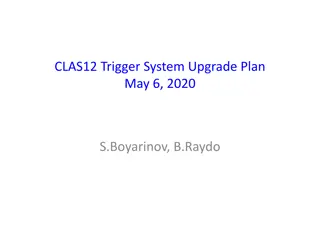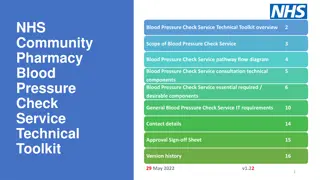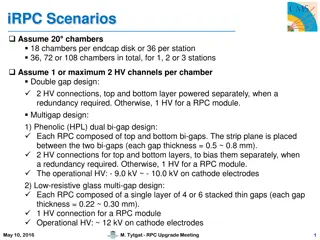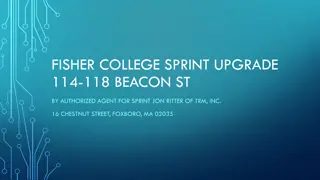Overview of OT Upgrade: Technical Aspects and Scope by Ulrich Heintz
Ulrich Heintz presents the technical aspects and scope of CD-3a procurement in the OT upgrade project, highlighting the importance of early silicon sensors procurement to avoid project delays. The overview includes design considerations for upgrading the current tracker system to meet HL-LHC operational requirements.
Download Presentation

Please find below an Image/Link to download the presentation.
The content on the website is provided AS IS for your information and personal use only. It may not be sold, licensed, or shared on other websites without obtaining consent from the author.If you encounter any issues during the download, it is possible that the publisher has removed the file from their server.
You are allowed to download the files provided on this website for personal or commercial use, subject to the condition that they are used lawfully. All files are the property of their respective owners.
The content on the website is provided AS IS for your information and personal use only. It may not be sold, licensed, or shared on other websites without obtaining consent from the author.
E N D
Presentation Transcript
402.3.2 Sensors 402.3.2 Sensors Ulrich Heintz HL-LHC CMS CD-3a Director s Review February 20, 2020
Outline Scope of CD-3a procurement Technical aspects of OT Sensors Context: L2 scope and U.S. Deliverables Design and Validation Technical Maturity QA/QC plans Management aspects of OT Sensors Cost, Schedule, Risks, and ES&H Summary 2/20/20 Ulrich Heintz HL-LHC CD-3a Director's Review OT L3 - Sensors 2
Biosketch for Ulrich Heintz Professor at Brown University (2009-now) L2 Deputy HL LHC CMS Upgrade - OT (June 2019-) CAM for HL LHC CMS Upgrade - OT Sensors (2016-now) L3 Manager HL LHC CMS Upgrade - OT Sensors (2016-2019) Co-coordinator of CMS OT Modules working group (2016-now) L3 Manager/CAM of USCMS Phase 1 HF FE upgrade (2013-2017) L3 manager of D0 L2 Silicon Track Trigger (1999-2006) Assistant/Associate Professor at Boston University (1998- 2009) QC for F-Disk Sensors Wilson Fellow at Fermilab (1995-1998) Development of F-Disk design for D0 Silicon Microstrip Tracker PhD from Stony Brook University (1991) CUSB 2/20/20 Ulrich Heintz HL-LHC CD-3a Director's Review OT L3 - Sensors 3
Scope of CD-3a Procurements Charge #1 We request approval to procure the silicon sensors for the OT upgrade prior to CD-3 approval Early procurement of the sensors is required because of the long production period to avoid delaying the completion of the project The scope of the procurement includes All sensors for the US part of OT upgrade Labor and M&S required for the associated QC activities 2/20/20 Ulrich Heintz HL-LHC CD-3a Director's Review OT L3 - Sensors 4
Technical Aspects 2/20/20 Ulrich Heintz HL-LHC CD-3a Director's Review OT L3 - Sensors 5
Overview of OT Upgrade Outer Tracker 2/20/20 Ulrich Heintz HL-LHC CD-3a Director's Review OT L3 - Sensors 6
Design Considerations Why upgrade? Current Tracker cannot perform adequately during HL-LHC operations Integrated luminosity The tracker must survive the target integrated luminosity of 3000/fb Radiation hard sensor and module design Pileup The tracker must be able to operate at up to 200 interactions/crossing Efficient tracking performance requires low occupancy Fine granularity macro pixel sensors and short strips in outer tracker Support of the level-1 track trigger L1 track trigger requires on-detector data reduction pT modules allow local track stub reconstruction Material budget Minimize the material in the tracker volume to optimize tracker and calorimeter performance 2/20/20 Ulrich Heintz HL-LHC CD-3a Director's Review OT L3 - Sensors 7
OT Fundamental Unit: Module Module components Sensors, frontend and service hybrids with ASICs, and mechanical support Novel pT module design Two coplanar sensors provide local curvature information for trigger Small number of module types Pixel-Strip (PS) Module: Strip sensor (1D information) + pixel sensor (2D information) at smaller radii Strip-Strip (2S) Module: Two strip sensors at larger radii to balance precision and cost Different sensor spacing at different radii to match trigger thresholds 2/20/20 Ulrich Heintz HL-LHC CD-3a Director's Review OT L3 - Sensors 8
OT Detector Layout Structured into 6 barrel layers and 2 5 endcap disks TB2S TEDD Flat TBPS Tilted TBPS Inner Tracker (Pixels) NSF scope Red: 2S modules at R > 600 mm Blue: PS modules at 200 < R < 600 mm 2/20/20 Ulrich Heintz HL-LHC CD-3a Director's Review OT L3 - Sensors 9
402.2 US Scope KPPs: DocDb-13237 Modules Main deliverable: 2500 PS and 2000 2S working production modules Plus 10% construction spares 952 PS modules assembled into Flat Barrel in US, rest to other CMS integration centers Sensors Procurement (CERN purchase), QC Electronics Development of test systems for all of CMS, procurement for US needs Development of MacroPixel Sub Assembly (MaPSA), procurement, QC Module assembly Development of assembly sites (East Coast and FNAL) Module component procurements and assembly into modules, QC Flat Barrel Fabrication Fabrication of planks and rings for the PS flat barrel (inner 3 layers) Assembly of PS modules onto planks/rings, QC US team is embedded in CMS organizational structure System Test, Modules, and CMS Upgrade Performance Studies groups Improves communication and coordination 2/20/20 Ulrich Heintz HL-LHC CD-3a Director's Review OT L3 - Sensors 10
Charge #3 Design Considerations for Sensors Relevant science requirements for the OT: Excellent momentum resolution (sci-req-4) Efficient pattern recognition and tracking (sci-req-3) Efficient reconstruction of the vertex associated to the hard scatter and of the vertices associated to the pile-up interactions (sci-req-7) Efficient reconstruction of secondary vertices (sci-req-8) Science-engineering and engineering requirements for the OT: Radiation tolerance (OT-engr-001): The upgraded tracker must be able to operate efficiently up to a target integrated luminosity of 3000/fb. Compliance with L1 trigger upgrade (OT-sci-engr-008) High granularity (OT-engr-011, OT-engr-012): occupancies as low as 1% are required to achieve efficient and robust pattern recognition and tracking. Optimal layout of layers (OT-sci-engr-001, OT-engr-002) Reduced material in tracking volume (OT-engr-005) Science Requirements for U.S. CMS HL-LHC: https://cms-docdb.cern.ch/cgi-bin/DocDB/ShowDocument?docid=13337 Outer Tracker Interfaces and Requirements for U.S. CMS HL-LHC: https://cms-docdb.cern.ch/cgi-bin/DocDB/ShowDocument?docid=13388 2/20/20 Ulrich Heintz HL-LHC CD-3a Director's Review OT L3 - Sensors 11
CMS Review Status Charge #6 Timeline of CMS reviews and procurement steps CERN market survey identified HPK as the only qualified vendor 29 January 2019: CMS Pre-PRR Part 1 13 March 2019: Finalize draft IT documents 14 March 2019: CMS Pre-PRR Part 2 3 April 2019: Dispatch IT documents 29 April 2019: HPK responds to IT documents 23 August 2019: Frame contract signed 17 September 2019: Review material/thickness 22 October 2019: Adjust order to material/thickness 30 January 2020: CMS PRR 2/20/20 Ulrich Heintz HL-LHC CD-3a Director's Review OT L3 - Sensors 12
Charge #3 Sensor Design Complete 3 sensor designs 2S, PS-s(trip), PS-p(ixel) Simple of design Parallel strips only No wedge shaped sensors No stereo sensors No stereo modules Strip sensors AC coupled sensors with poly silicon bias resistor Segmented in center Readout via wire bonds from ends PS-p sensor DC coupled sensor biased through readout chip Segmented into 100 x 1500 m2 pixels Readout via bump bonds Sensor Width Length Pitch Strips 2S 94 mm 103 mm 90 m 2x1016 PS-s 98 mm 49 mm 100 m 2x960 PS-p 99 mm 49 mm 100 m 32x960 PS-s 2S PS-p 2/20/20 Ulrich Heintz HL-LHC CD-3a Director's Review OT L3 - Sensors 13
Charge #3 FZ290 Sensors from HPK FZ290 sensor material p-doped FZ silicon with 320 m thickness 30 m backside n-implant active thickness 290 m HPK has delivered 30 2S sensors of the final design IV and CV characteristics look good Strip parameters satisfy specifications Parameter Measured Specification Coupling capacitance (pF/cm) Bias resistor (M ) 30 >24 1.8-2.1 1-2 Strip current (pA/cm) 5-25 <2000 Interstrip capacitance (fF/cm) Interstrip resistance (G cm) 300-400 <500 >1000 >10 Long term behavior is stable 2/20/20 Ulrich Heintz HL-LHC CD-3a Director's Review OT L3 - Sensors 14
Charge #3 Expected Tracking Performance Simulations show the expected tracking performance Intrinsic performance of upgraded tracker exceeds that of current tracker Performance of upgraded tracker is robust wrt pileup The Phase-2 Upgrade of the CMS Tracker (CERN-LHCC-2017-009, CMS-TDR-17-001) 2/20/20 Ulrich Heintz HL-LHC CD-3a Director's Review OT L3 - Sensors 15
Charge #3 Radiation Hardness Expected exposure Expected fluence for 2S modules < 3 1014 n/cm2 Expected fluence for PS modules < 1 1015 n/cm2 Signal threshold Digital readout look at signal from seed strip Threshold > 4 times noise rms noise occupancy 6 10 5 Required signal MPV > 3 threshold Sensor Chip Noise Threshold MPV 2S CBC 1000 4000 12000 PS-s SSA 800 3200 9600 PS-p MPA 250 1000 3000 2/20/20 Ulrich Heintz HL-LHC CD-3a Director's Review OT L3 - Sensors 16
Charge #3 Radiation Hardness 64 strips 2 cm Seed signal After 3 1014 n/cm2 MPV for FZ290 sensors is well above 2S requirement After 1 1015 n/cm2 MPV for FZ290 sensors is well above PS requirement when operated at 800 V bias voltage Strip parameters do not show severe changes after irradiation 2/20/20 Ulrich Heintz HL-LHC CD-3a Director's Review OT L3 - Sensors 17
Charge #3 Radiation Hardness Performance with CBC chip After 5 1014 n/cm2 Signal efficiency > 99% Noise occupancy 10 5 Current of full size 2S sensor After 4 1014 n/cm2 Total current is well below limit of 1mA at 600V and -20 C 2/20/20 Ulrich Heintz HL-LHC CD-3a Director's Review OT L3 - Sensors 18
Charge #7 Quality Assurance Design test structures into wafers to verify production Two PQC halfmoons per wafer 2 x PQC flutes: main tool for PQC Diodes and MOS structures Other specialized structures Irradiation halfmoon Test sensor with 60 strips Diodes of different sizes Flutes for resistivity measurements 2/20/20 Ulrich Heintz HL-LHC CD-3a Director's Review OT L3 - Sensors 19
Charge #7 Quality Control Quality control plan Vendor QC all sensors Sensor QC 2 sensors/batch Optical inspection & cut precision Electrical characterization Long term behavior Process QC structures from each batch Flutes with test structures Batch qualification Ok for assembly if SQC and PQC ok Reject if >3 bad wafers Irradiation tests Irradiate test sensors and structures Evaluate before and after irradiation Longer turn around time All results will be stored in CMS data base QC centers must comply with environmental requirements set by HPK 2/20/20 Ulrich Heintz HL-LHC CD-3a Director's Review OT L3 - Sensors 20
QC Centers Charge #7 There are two QC centers in the US University of Rochester SQC ready Will test sensors batches to be assembled at Fermilab PQC being set up Brown University SQC ready (move to new prober) Will test sensor batches to be assembled on East Coast PQC ready Irradiation tests Neutrons at RI Nuclear Science Center - ready Protons at Fermilab ITA under construction Measurements at Brown Draft QC documents* SQC: https://edms.cern.ch/nav/P:CMS-0000010506:V0/D:2314384:V1 PQC: https://edms.cern.ch/nav/P:CMS-0000010506:V0/D:2314841:V1 IT: https://edms.cern.ch/nav/P:CMS-0000010506:V0/D:2314785:V1 *can be provided upon request 2/20/20 Ulrich Heintz HL-LHC CD-3a Director's Review OT L3 - Sensors 21
Management Aspects 2/20/20 Ulrich Heintz HL-LHC CD-3a Director's Review OT L3 - Sensors 22
Charge #5 Cost Estimate Costbook M&S component Dominated by cost of sensors Some funds for irradiation tests and shipping Labor component Labor for QC activities 2/20/20 Ulrich Heintz HL-LHC CD-3a Director's Review OT L3 - Sensors 23
Breakdown of M&S BOE Charge #5 Cost of sensors Based on costs in contract in JPY Convert to US$, scale NRE to US scope to obtain US cost Reduce by costs of MAPSAs which US procures for PS modules assembled in other countries ($1,014,210) Sensor Cost per sensor Number of sensors NRE cost share Total cost After MAPSA correction 2S $691 4400 $20,835 $3,059,785 $2,440,927 PS-s $362 2750 $35,433 $1,031,810 $823,122 PS-p $300 3000 $22,779 $922,914 $736,250 Total $5,014,509 $4,000,299 Remaining M&S for QC activities $4,071,695 total 2/20/20 Ulrich Heintz HL-LHC CD-3a Director's Review OT L3 - Sensors 24
Breakdown of Labor BOE Charge #5 2S Sensor QC Preproduction Production Labor hours Sensor QC Sensor logistics (unpack, store, data base, ship) Visual inspection CV/IV characteristics Strip measurements Process QC 2 halfmoons/wafer Irradiation tests one irradiation every 3 weeks Characterization of samples Number of sensors 200 4200 Logistics 0.5h 0.5h Number of sensors 200 336 CV/IV + visual 3.5h 3.5h Strip QC 8.0h 8.0h Total hours 2400h 5980h 2S Process QC Preproduction Production Number of wafers 40 336 PQC 4.0h 4.0h Total hours 160h 1340h 2S Irradiation tests Preproduction Production N-irradiations 2 10 Labor 48h 48h P-irradiations 1 10 Labor 56h 56h Total hours 152h 1040h 2/20/20 Ulrich Heintz HL-LHC CD-3a Director's Review OT L3 - Sensors 25
Fiscal Quarter Cost Profile Charge #5 Cost Distributed uniformly throughout production period $400k/quarter for 3 years Labor Peak in the beginning intense testing of preproduction Uniform distribution for rest of production at 2 FTE 2/20/20 Ulrich Heintz HL-LHC CD-3a Director's Review OT L3 - Sensors 26
Estimate Uncertainty Charge #5 EU for M&S Mostly M3, some M4 EU for Labor All L4 2/20/20 Ulrich Heintz HL-LHC CD-3a Director's Review OT L3 - Sensors 27
Charge #4 Risks - Sensors Charge #5 2/20/20 Ulrich Heintz HL-LHC CD-3a Director's Review OT L3 - Sensors 28
Schedule Overview Charge #5 Sensor delivery schedule Negotiated between CMS, ATLAS, and HPK Preproduction sensors are available after July 8, 2020 Ramp up of production over 4 months Production sensors available after October 28, 2020 HPK will deliver 1600 wafers per quarter All sensors delivered by April 2024 QC schedule QC will keep up with sensor delivery Year Quarter Month 2021 2022 2023 2024 Q2'20 Q3'20 Q4'20 Q1'21 Q2'21 Q3'21 Q4'21 Q1'22 Q2'22 Q3'22 Q4'22 Q1'23 Q2'23 Q3'23 Q4'23 Q1'24 Q2'24 TOTAL PREPRODUCTION & PRODUCTION 4 5 6 7 8 9 10 11 12 1 2 3 4 5 6 7 8 9 10 11 12 1 2 3 4 5 6 7 8 9 10 11 12 1 2 3 4 5 6 7 8 9 10 11 12 1 2 3 4 5 6 2S PS-s (equivalent number of wafers) PS-p (equivalent number of wafers) TOTAL (equivalent number of wafers) 0 17050 0 3150 0 3800 0 24000 80 150 150 260 376 376 376 376 376 376 376 376 376 376 376 376 376 376 376 376 376 376 376 376 376 376 376 376 376 376 376 376 376 376 376 376 376 376 376 376 438 439 437 437 438 685 80 60 60 80 67 67 67 67 67 67 67 67 67 67 67 67 67 67 67 67 67 67 67 128 120 140 140 91 91 91 91 91 91 91 91 91 91 91 91 91 91 91 91 91 91 91 288 330 350 480 533 533 533 533 533 533 533 533 533 533 533 533 533 533 533 533 533 533 533 533 533 533 533 533 533 533 533 533 533 533 533 533 533 533 533 533 528 539 537 537 526 685 0 0 0 0 0 0 67 91 67 91 67 91 67 91 67 91 67 91 67 91 67 91 67 91 67 91 67 91 67 91 67 91 67 91 67 91 67 91 67 91 82 100 100 100 8 88 0 0 0 Quarterly Sum* 0 968 1547 1600 1600 1600 1600 1600 1600 1600 1600 1600 1600 1600 1600 1600 685 24000 2/20/20 Ulrich Heintz HL-LHC CD-3a Director's Review OT L3 - Sensors 29
Milestones Charge #5 Sensor milestones Milestones exist to monitor the completion of QC for each batch PS-p PS-s 2S 2/20/20 Ulrich Heintz HL-LHC CD-3a Director's Review OT L3 - Sensors 30
Critical Path Items for CD-3a Scope Charge #2 If sensor procurement waits for CD-3 Sensors would be on the critical path Project completion would be delayed by about 3 months Early procurement of sensors keeps them off the critical path All Sensors on CD-3a PS-p PS-p Sensors on CD-3 MAPSA PS modules 2/20/20 Ulrich Heintz HL-LHC CD-3a Director's Review OT L3 - Sensors 31
ESH specific to Sensors Charge #8 PHAR for sensors lists Electrical hazards Sensor bias voltage during sensor tests. Mitigated by shielding and enclosures that prevent physical contact. Fire hazards The wiring and the electrical equipment used in sensor testing may present a fire hazard. Mitigated by equipment that satisfies applicable safety standards. Radiation hazards Radioactive sources may be used in the testing of the sensors. Mitigated by appropriate radiation safety training. ESD Hazards Sensors could be damaged by ESD. Mitigated by ESD protection measures according to industrial best practice and ESD training. ESH Compliance checked as part of site visits Brown (September 13, 2019) Rochester (March 24, 2020) 2/20/20 Ulrich Heintz HL-LHC CD-3a Director's Review OT L3 - Sensors 32
Summary Charge #10 The sensor design for the OT upgrade is complete HPK has been identified as the sole qualified vendor by the CERN market survey Prototype sensors satisfy specifications The costs and delivery schedule are well understood Procurement of all sensors was approved by CMS in a PRR on January 30, 2020 The procurement contract has been signed A QA/QC plan is in place We are ready for CD-3a 2/20/20 Ulrich Heintz HL-LHC CD-3a Director's Review OT L3 - Sensors 33
Backup 2/20/20 Ulrich Heintz HL-LHC CD-3a Director's Review OT L3 - Sensors 34
Sensor QC Charge #7 Full electrical characterisation of a sensor (2S/PS-s) IV curve up to 1000 V Ensure currents are low: No breakdown up to 800 V: CV curve up to 600 V Extract full depletion voltage: Measurements on each strip Strip current Bias resistor resistance Coupling capacitance Current through the dielectric Interstrip measurements on a sample of strips (every 50th) Interstrip resistance Interstrip capacitance Additional bad strip detection Bad strips are: pinholes, metal shorts/opens, implant shorts/opens Number of bad strips allowed US sensor procurement: 5 2S and PS-s batches per month 10 sensors/month Maximum throughput 1 sensor per day per center I600 < 2.5 nA/mm3 (7.25/3.625 A) I800 < 2.5 x I600 Vfd < 350 V Istrip < 10 nA/cm (50/25 nA) Rpoly =1.5 0.5 M Cac > 1.2 pF/cm m (132/75 pF) Idiel < 10 nA@10 V Rint: > 10 G cm Cint: < 0.5 pF/cm Nbs: 20 2/20/20 Ulrich Heintz HL-LHC CD-3a Director's Review OT L3 - Sensors 35
Process QC Charge #7 Set of test structures, accessed through arrays of 2 10 pads (flutes) Facilitates automated measurement with probe card Inspired by industry Quick Flute 1 and Quick Flute 2 Access to most relevant process parameters Substrate resistivity Oxide quality Si/SiO2 Interface Sheet resistances Inter-strip resistance Extended Flutes Provide additional test structures for more detailed measurements to diagnose problems US sensor procurement: 7 batches per month 28 halfmoons per month Maximum throughput 8 halfmoons/day 2/20/20 Ulrich Heintz HL-LHC CD-3a Director's Review OT L3 - Sensors 36
Irradiation Tests Charge #7 Main irradiation TS Mini strip sensor (60 2.3cm-long strips, 90/100 m pitch for 2S/PS-s wafer) Diodes: full size, half size, half size with p-stop, quarter size PQC test structure flutes Before irradiation Characterize all test structures and sensors After irradiation Anneal 20min at 60 C Measurements for diodes (all wafer types) IV and CV characteristics Measurements for mini-sensors (2S and PS-s wafer) IV and CV characteristics Ileak, CC, Rpoly, Idiel, Cint, Rint for all strips @ 600V Charge collection versus annealing time Measurements for single-PS-p sensor Ileak and Rint for 100 pixels @ 600V One irradiation every 3 weeks with 3 sensors, 3 diode sets, 1 small PS-p sensor Add. irrad. TS Main irrad. TS Spares 2/20/20 Ulrich Heintz HL-LHC CD-3a Director's Review OT L3 - Sensors 37
Risk RT-402-2-23-D Charge #4 OT vendor is unable to produce sensors to specifications Very unlikely (5%) but large maximum impact ($2.7M) Develop new vendor 6 months < delay < 12 months @ burn rate of $35k/month Cost may increase by up to 66%. 20% are covered by EU maximum impact is 46% of sensor cost = $2.3M $210k < cost impact < $2.7M Strip sensors HPK has delivered 2S sensors that satisfy specifications PS-s sensors are technically the same (except half size) Retire this risk for strip sensors before CD-3a review Pixel sensors Mini-modules have been tested but not full-size sensor of final design Retain risk for PS-p sensor for now (46% of PS-p cost = $425k) $210k < cost impact < $850k 2/20/20 Ulrich Heintz HL-LHC CD-3a Director's Review OT L3 - Sensors 38
402.2.3 WBS Structure Where does your item live in WBS space 2/20/20 Ulrich Heintz HL-LHC CD-3a Director's Review OT L3 - Sensors 39























